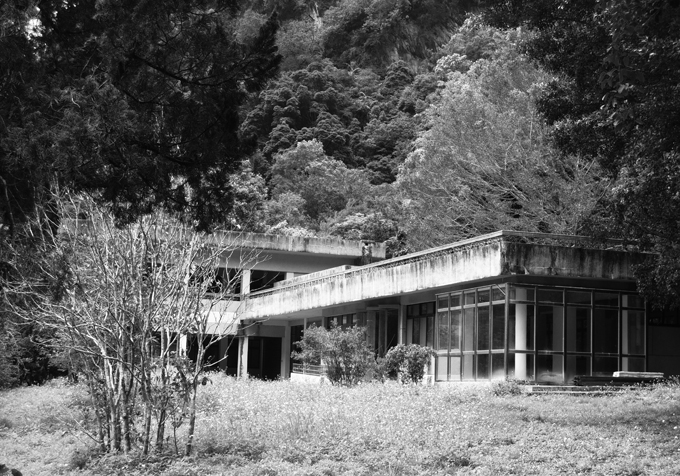
Keelung Islet Tourist Center, off the northern shore of Taiwan. Construction finished in 2006; cost: about NT $10,000,000. Photo by Ko Chun-Yao, 2010.
In 2010, I was set to teach courses on contemporary photography and performance art at two major Taiwanese universities. Before each class began, I posed a question to my students: Would they prefer that I follow a conventional curriculum and use textbooks? Or would they prefer to turn their class into a field survey of “Mosquito Halls”—abandoned public construction projects that were now, as their colloquial name suggests, only good for breeding mosquitoes?
There was a trove of history for my students to explore if they chose the latter option, and it would touch on a sensitive subject art history textbooks don’t take up: Taiwan’s history of troubled public construction projects. Following the end of 38 years of martial law in 1987, Taiwan has continually undergone massive and misguided building sprees to spur economic development and promote local Taiwanese identity and culture. After the ribbons were cut and the fanfare had died down, hundreds of facilities did not operate as planned. Budgets were mismanaged, buildings were poorly maintained, visitor numbers were too low to support businesses and locals found no practical use for the facilities. Throughout Taiwan, abandoned swimming pools, deserted shopping malls, decaying beautification projects and derelict community centers turned into Mosquito Halls.

Neglected interior of Keelung Islet Tourist Center, off the northern shore of Taiwan. Construction finished in 2006; cost: about NT $10,000,000. Photo by Ko Chun-Yao, 2010.
Given the prevalence and mystery of these public ruins, my students opted unanimously to survey the Mosquito Halls, often inviting their friends and family to tag along. They even formed a temporary organization to catalogue and raise questions about the abandoned projects, which they called the “Lost Society Document.” Over the next six months, my students and I traveled across Taiwan, documenting 147 such buildings in photographs and writing. These findings became the focus of a 600-page book, Mirage: Disused Public Property in Taiwan.
Photographs from Mirage were featured at the Taipei Biennial, and I also sent the book to journalists and politicians, triggering an onslaught of coverage that caught the government’s attention. Taiwan’s president and vice president subsequently reached out to my team to express not only their concerns but also support. The prime minister met with us, vowing that government agencies would conduct extensive investigations and revitalize the Mosquito Houses within a year. For the buildings that were beyond restoration or utilization, the government would consider demolition.

Wenshan Hotel, Taroko National Park, Hualien County, eastern Taiwan. Construction date unknown; cost unknown. Photo by Zhou Quanli, 2013.
In October 2011, one year after the premier’s widely publicized pledge to revitalize the Mosquito Halls, I led the Lost Society Document team on a new round of surveys. We found an additional 100 cases—which we subsequently published as a second volume of Mirage—raising doubts about the government’s promise of revitalization. Two years later, we were amazed to discover yet another 100 cases. Our findings prompted us to create a third volume. All three tomes created an additional wave of public pressure, and prompted senior government leaders to once again publicly promise that they would reflect on their mistakes and finish reinvestigating Mosquito Halls across Taiwan within a month. It has been over three years since they first promised investigations and revitalization of the buildings, and we are still waiting to see any substantial action.
Yao Jui-chung’s images of Taiwan’s Mosquito Halls were featured in an article on Foreign Policy published in tandem with the above photo-essay.


